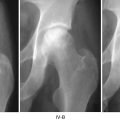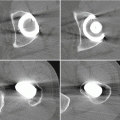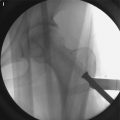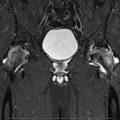© Springer-Verlag Berlin Heidelberg 2014
Kyung-Hoi Koo, Michael A. Mont and Lynne C. Jones (eds.)Osteonecrosis10.1007/978-3-642-35767-1_1212. Corticosteroid Usage and Osteonecrosis of the Hip
Jeffrey J. Cherian1 , Bhaveen H. Kapadia1 , Samik Banerjee1 , Julio J. Jauregui1 and Michael A. Mont1
(1)
Department of Orthopaedic Surgery, Rubin Institute for Advanced Orthopedics, Center for Joint Preservation and Replacement, Sinai Hospital of Baltimore, 2401 West Belvedere Avenue, Baltimore, MD 21215, USA
12.1 Introduction
The disease process of atraumatic osteonecrosis was first described as ischemic necrosis of the hip [1]. This pathological process can lead to destructive arthritis in multiple joints, most commonly occurring in the hips, knees, shoulders, and ankles [1]. Currently, there is no consensus on the pathophysiological mechanism of osteonecrosis, but it is thought to be multifactorial in nature. However, there are certain direct risk factors implicated in the development of osteonecrosis such as trauma, radiation, Caisson’s disease, and sickle cell disease [2]. In addition, various other risk factors have been shown to have a direct correlation with osteonecrosis such as corticosteroids, habitual alcohol intake, hyperlipidemia, chemotherapeutic agents, systemic lupus erythematosus, lipid storage diseases, and inflammatory bowel disease [3, 4].
In 1958, Chandler and Wright described the adverse effects of high-dose intra-articular corticosteroid injection [5]. Later in 1960, Heimann and Freiberger noticed similar results seen with high-dose oral corticosteroids on the femoral and humeral head [6]. Although there are several theories behind corticosteroid-induced osteonecrosis, it is generally thought to be caused by vascular compromise to the femoral head. The most widely accepted mechanism of corticosteroid-induced osteonecrosis results from adipocyte hypertrophy which increases intraosseous pressure causing extramural compression of the vasculature to the femoral head [7]. This leads to a disruption in blood flow, which causes a lack of delivered vital nutrients. In addition, corticosteroids have been found to cause a decrease in osteoclast and osteoblast activity, which subsequently results in decreased bony turnover, trabecular width, density, and formation [8].
Recently, numerous studies have shown there to be a direct correlation between the use of high-dose corticosteroids and the increased risk of osteonecrosis. It is widely accepted that doses greater than 2 g over a 3-month interval impart the greatest risk for the development of corticosteroid-induced osteonecrosis [2]. This chapter therefore aims to evaluate the effects of corticosteroids on the incidence of osteonecrosis of the hip , particularly in relation to dosing, and duration of treatment, and the effects of pulse therapy.
12.2 Treatment Dosing
Current studies demonstrate that there is a direct correlation between the incidence of osteonecrosis and the use of corticosteroids. A recent study by Felson et al. demonstrated that the incidence of corticosteroid-induced osteonecrosis may be increasing due to higher dosing regimens. The authors found there to be a 4.6 % increase in incidence of osteonecrosis with every 10 mg/day increase in corticosteroid use. Additionally, it was seen that the daily dose of corticosteroid may be one of the greatest risk factors for osteonecrosis (R 2 = 0.75) [9]. Similarly, the incidence of osteonecrosis has been reported to be higher with a mean daily dose of > 40 mg/day. Shigemura et al. in a prospective randomized study found a fourfold increase in the risk of osteonecrosis with the use >40 mg/day of corticosteroids (OR = 4.2; p = 0.001). This study showed that an increase in the mean daily dose may result in an increased incidence of osteonecrosis [10].
In a prospective study of 45 patients diagnosed with systemic lupus erythematosus (SLE), Nagasawa et al. examined the dose–response relationship with development of osteonecrosis over a 5-year period. During this period patients had magnetic resonance imaging (MRI) evaluations every year following initiation of 40 mg/day of corticosteroid therapy. The authors demonstrated that the cohort who developed osteonecrosis had a significantly higher proportion of patients who received >1,000 mg/day of corticosteroids than that group of patients who demonstrated no radiographic evidence of the disease (87 % versus 37 %; p < 0.01) [11].
Studies have also demonstrated that patients receiving a cumulative dose of corticosteroids >2 g are at a higher risk for developing osteonecrosis. A retrospective study by Nakamura et al., who examined 201 SLE patients over a 13-year period, demonstrated that 15 % of patients who received high corticosteroid doses had increased risks of developing osteonecrosis [4].
The cumulative corticosteroid dosage has been shown to have a direct association with the risk of osteonecrosis. In particular, a study by Shjibatani et al. found that patients who have had renal transplantation are at a potentially higher risk of developing osteonecrosis. The authors found that patients who received ≤1,795 mg and >1,795 mg of cumulative steroid dosing over an 8-week period after renal transplantation had higher risks of developing osteonecrosis compared to those who received less than 1,400 mg of corticosteroids (hazards ratio, 2.9 and 3.2, respectively; p = 0.07 and 0.07, respectively) [12].
Stay updated, free articles. Join our Telegram channel

Full access? Get Clinical Tree








